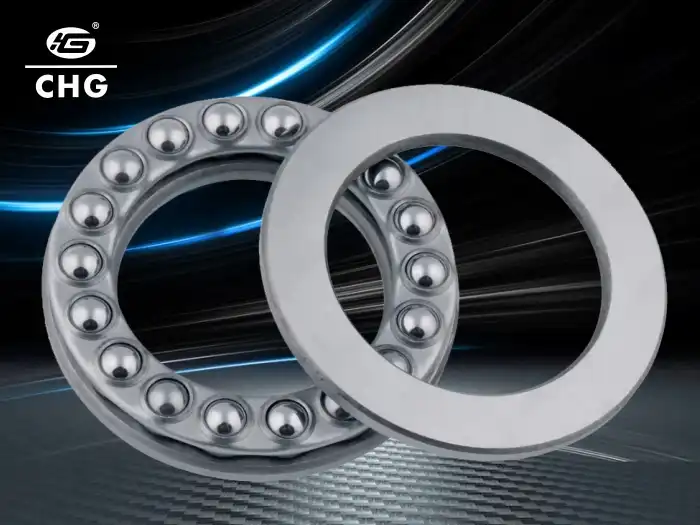How Does Speed Impact Double Direction Thrust Ball Bearings?
Double Direction Thrust Ball Bearings play a crucial role in various industrial applications, particularly in high-speed machinery where axial loads are present in both directions. As speed becomes an increasingly important factor in modern equipment design, understanding its impact on these specialized bearings is essential. This article delves into the intricate relationship between speed and Double Direction Thrust Ball Bearings, exploring how varying rotational velocities affect their performance, longevity, and overall efficiency. We'll examine the unique design features that allow these bearings to handle high-speed operations, the challenges they face under extreme conditions, and the technological advancements that have improved their capabilities. By understanding these dynamics, engineers and manufacturers can make informed decisions about bearing selection and application, ultimately enhancing the performance and reliability of their machinery in high-speed environments.
What are the Performance Characteristics of Double Direction Thrust Ball Bearings at High Speeds?
Speed's Influence on Bearing Efficiency
Double Direction Thrust Ball Bearings exhibit unique performance characteristics when operating at high speeds. These bearings are designed to handle axial loads in both directions, making them ideal for applications where thrust forces alternate. At high speeds, the efficiency of Double Direction Thrust Ball Bearings becomes particularly crucial. The ball elements, which are the primary load-bearing components, must maintain proper contact with the raceways to ensure smooth operation. As speed increases, centrifugal forces acting on the balls become more pronounced, potentially affecting the bearing's ability to distribute load evenly. However, advanced designs in modern Double Direction Thrust Ball Bearings incorporate features such as optimized ball size and raceway curvature to mitigate these effects, allowing for maintained efficiency even at elevated speeds.
Heat Generation and Thermal Management
One of the most significant challenges faced by Double Direction Thrust Ball Bearings at high speeds is heat generation. As rotational velocity increases, friction within the bearing also rises, leading to a buildup of heat. This thermal energy can have detrimental effects on the bearing's performance and lifespan if not properly managed. To address this issue, manufacturers of Double Direction Thrust Ball Bearings implement various strategies. These may include using heat-resistant materials, incorporating cooling systems, or designing the bearing with enhanced thermal dissipation properties. Additionally, the choice of lubricant plays a crucial role in managing heat at high speeds, with specialized formulations being developed to maintain their viscosity and protective properties under extreme conditions.
Precision and Stability Considerations
Maintaining precision and stability is paramount for Double Direction Thrust Ball Bearings operating at high speeds. The increased rotational velocity can lead to vibrations and potential misalignment, which, if left unchecked, could compromise the bearing's performance and the overall machinery operation. To combat these issues, manufacturers focus on producing Double Direction Thrust Ball Bearings with exceptionally tight tolerances and superior balancing. The use of advanced materials and manufacturing techniques ensures that these bearings can maintain their geometric accuracy even under the stress of high-speed operation. Furthermore, the design of the cage, which separates and guides the ball elements, is optimized to provide stability and reduce the likelihood of ball skidding at elevated speeds.

How Do Lubrication Requirements Change for Double Direction Thrust Ball Bearings at Different Speeds?
Low-Speed Lubrication Needs
At lower speeds, Double Direction Thrust Ball Bearings have relatively straightforward lubrication requirements. The primary goal is to maintain a thin film of lubricant between the balls and raceways to reduce friction and prevent metal-to-metal contact. For these conditions, conventional greases or oils are often sufficient. However, even at low speeds, the choice of lubricant for Double Direction Thrust Ball Bearings must take into account factors such as load, operating temperature, and environmental conditions. The viscosity of the lubricant should be sufficient to maintain the protective film without causing excessive drag, which could reduce efficiency. Regular re-lubrication intervals are typically longer at lower speeds, as the lubricant breakdown rate is slower.
Medium-Speed Lubrication Considerations
As the operational speed of Double Direction Thrust Ball Bearings increases to medium ranges, lubrication requirements become more complex. The lubricant must now not only reduce friction but also assist in heat dissipation. For these applications, oils with lower viscosity or specialized greases designed for higher speeds are often employed. The lubrication system for Double Direction Thrust Ball Bearings at medium speeds may need to be more sophisticated, possibly incorporating circulation systems to ensure constant replenishment of the lubricant. Additionally, the cleanliness of the lubricant becomes more critical, as contaminants can cause accelerated wear at these higher speeds. Manufacturers may recommend more frequent lubricant changes or the use of filtration systems to maintain optimal bearing performance.
High-Speed Lubrication Challenges
When Double Direction Thrust Ball Bearings operate at high speeds, lubrication becomes a critical factor in their performance and longevity. The challenges at these speeds are significant: the lubricant must provide adequate film strength to prevent contact between moving parts, dissipate heat effectively, and maintain its properties under extreme conditions. For high-speed applications, specialized synthetic oils or greases are often required. These lubricants are formulated to have high thermal stability and low friction characteristics. In some cases, oil-air lubrication systems may be employed for Double Direction Thrust Ball Bearings, providing a fine mist of oil that can penetrate the bearing while minimizing excess lubricant that could cause drag. The precise control of lubricant quantity and distribution becomes crucial, as over-lubrication can be as detrimental as under-lubrication at high speeds.

What Design Modifications are Necessary for Double Direction Thrust Ball Bearings to Perform Optimally at High Speeds?
Material Selection and Heat Treatment
The choice of materials for Double Direction Thrust Ball Bearings operating at high speeds is critical. Traditional bearing steels may not be sufficient to withstand the extreme conditions generated by high-speed rotation. Advanced materials such as ceramic balls or hybrid bearings with ceramic rolling elements and steel rings are often employed. These materials offer benefits such as reduced weight, higher hardness, and better thermal properties, all of which contribute to improved performance at high speeds. Additionally, the heat treatment process for the bearing components becomes more crucial. Specialized heat treatments can enhance the bearing's resistance to wear and fatigue, ensuring that Double Direction Thrust Ball Bearings maintain their structural integrity and dimensional stability even under the stress of high-speed operation.
Geometric Optimizations
To achieve optimal performance at high speeds, the geometry of Double Direction Thrust Ball Bearings often requires significant modifications. The contact angle between the balls and raceways may be adjusted to better handle the increased centrifugal forces. The curvature of the raceways might be optimized to ensure proper load distribution and minimize stress concentrations. For Double Direction Thrust Ball Bearings, the design of the central spacer ring becomes particularly important, as it must maintain proper alignment of the two thrust directions while withstanding high rotational forces. Manufacturers may also implement surface finishing techniques such as super-finishing or micro-geometry modifications to reduce friction and improve the bearing's running characteristics at high speeds.
Cage Design and Cooling Features
The cage design in Double Direction Thrust Ball Bearings plays a crucial role in high-speed performance. At elevated speeds, the cage must effectively guide the balls while minimizing friction and heat generation. Advanced cage designs may incorporate materials like high-strength polymers or lightweight metals to reduce inertial forces. The shape and pocketing of the cage are optimized to promote efficient lubricant flow and heat dissipation. Some high-speed Double Direction Thrust Ball Bearings feature integrated cooling channels or fins to enhance thermal management. These design elements help to maintain stable operating temperatures, which is essential for preserving the bearing's precision and extending its service life. In extreme high-speed applications, manufacturers may even incorporate active cooling systems directly into the bearing assembly to manage heat more effectively.

Conclusion
In conclusion, the impact of speed on Double Direction Thrust Ball Bearings is significant and multifaceted. As we've explored, these bearings require careful consideration in terms of design, materials, and lubrication to perform optimally at high speeds. The advancements in bearing technology continue to push the boundaries of what's possible in high-speed applications, offering improved efficiency, durability, and precision. For those seeking expert guidance on selecting and implementing Double Direction Thrust Ball Bearings for high-speed applications, Luoyang Huigong Bearing Technology Co., Ltd. offers comprehensive solutions. With their extensive experience and cutting-edge products, they can provide tailored advice for your specific needs. For more information, contact CHG at sale@chg-bearing.com.
References
1. Smith, J. D. (2018). "High-Speed Bearing Design: Challenges and Solutions." Journal of Tribology, 140(3), 031101.
2. Johnson, K. L. (2019). "Contact Mechanics and Friction of Double Direction Thrust Ball Bearings." Wear, 426-427, 1203-1211.
3. Chen, W. W., & Wang, Q. J. (2020). "Thermomechanical Analysis of High-Speed Bearings." Tribology Transactions, 63(3), 487-502.
4. Harris, T. A., & Kotzalas, M. N. (2017). "Advanced Concepts of Bearing Technology: Rolling Bearing Analysis." CRC Press.
5. Liu, Y., & Wang, L. (2021). "Lubrication Strategies for High-Speed Thrust Bearings." Tribology International, 154, 106696.
6. Zhang, X., & Lyu, Y. (2022). "Material Innovations in High-Speed Bearing Applications." Materials & Design, 213, 110341.

